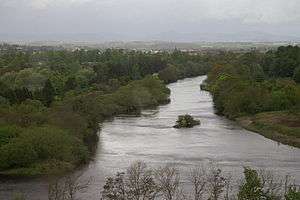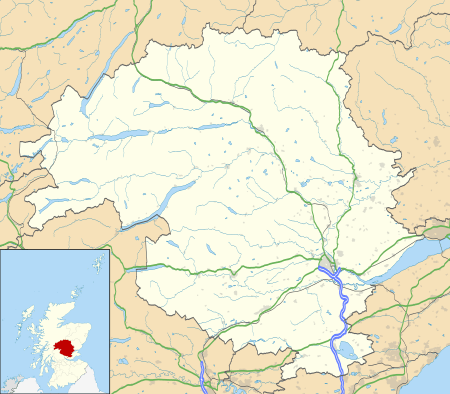Battle of Two Rivers
The Battle of Two Rivers was fought between the Picts and Northumbrians in the year 671. The exact battle site is unknown. It marked the end of the Pictish rebellion early in the reign of Ecgfrith, with a decisive victory for the Northumbrians. Attestation of the battle is limited to the account in Stephen of Ripon's Vita Sancti Wilfrithi.
| Battle of Two Rivers | |||||||
|---|---|---|---|---|---|---|---|
 Moncrieffe Island near Perth; suggested location of the Battle of Two Rivers | |||||||
| |||||||
| Belligerents | |||||||
| Picts | Northumbrians | ||||||
| Commanders and leaders | |||||||
| Drest VI | Ecgfrith | ||||||
Background
During the 7th century, the Northumbrians gradually extended their territory to the north. The Annals of Tigernach record a siege of "Etain" in 638,[1] which has been interpreted as Northumbria's conquest of Eidyn (Edinburgh) during the reign of Oswald, marking the annexation of Gododdin territories to the south of the River Forth.[2]
To the north of the Forth, the Pictish nations consisted at this time of the Kingdom of Fortriu to the north of the Mounth, and a "Southern Pictish Zone", to the south, stretching as far as the Forth.[3] Evidence from the 8th century Anglo-Saxon historian Bede points to the Picts also being subjugated by the Northumbrians during Oswald's reign,[4] and that this subjugation continued into the reign of his successor, Oswiu.[5]
Ecgfrith succeeded Oswiu as king of Northumbria in 670. Ecgfrith's kingdom was said to have been 'weak' on his ascent to the throne. In 671, word reached Ecgfrith that the Picts, under the command of the Verturian king, Drest mac Donuel, were preparing to rebel and overthrow the Northumbrian hegemony.[6]
Account of battle
| "He [Ecgfrith] slew an enormous number of the people, filling two rivers with corpses, so that, marvellous to relate, the slayers, passing over the rivers dry foot, pursued and slew a crowd of fugitives[.]" |
| — Stephen of Ripon's account of the battle from Vita Sancti Wilfrithi.[7] |
The record and description of the battle is limited entirely to Stephen of Ripon's account in his Vita Sancti Wilfrithi. According to this account, Ecgfrith became aware of the Picts plans to overthrow the Northumbrian suzerainty and he hastily assembled an invasion force of horsemen. He headed north, aided by his sub-king Beornhæth,[8] who historian James Fraser suggests may have ruled the southern Pictish kingdom of Niuduera, identified as being located in present-day Fife.[9]
The battle location is not recorded, but Fraser tentatively suggests that the battle may have occurred in the vicinity of Moncreiffe Island, near Perth.[10]
As recorded in Vita Sancti Wilfrithi, Ecgfrith's cavalry was ambushed by a concealed and much larger Pictish army. Nevertheless, the Northumbrians prevailed, with Pictish casualties being of sufficient number to 'fill two rivers', allowing the Northumbrian cavalry to pursue Pictish survivors without getting their feet wet.[7]
As a work of hagiography, Vita Sancti Wilfrithi is not an ideal historical source and it has been suggested that its partisan treatment of Northumbrian history inspired Bede's Historia Ecclesiastica.[11] Various details of Stephen's account of the battle are likely to have been exaggerated, overstating the extent of Ecgfrith's victory.[12]
Aftermath
Stephen records that, following the battle, the Picts were reduced to slavery and subject to the yoke of captivity for the next 14 years.[13] The Irish annals of Ulster and Tigernach record of a 'Drost' being expelled from kingship in 671.[14] It is generally presumed that this was the Pictish king, Drest, and that he was deposed and replaced by Bridei mac Bili as a direct result of the failure of the Pictish rebellion.[15]
Bridei was later to defeat and kill Ecgfrith in the Battle of Dun Nechtain in 685.[16]
Notes
- Annals of Tigernach T640.1; Annals of Ulster U638.1
- Jackson 1959, pp. 35–42; Smyth 1984, p. 31; Fraser 2009, p. 171
- Woolf 2006; Fraser 2009, p. 184
- Bede III: VI (Oswald "brought under his dominion all the nations and provinces of Britain, which are divided into four languages, viz. the Britons, the Picts, the Scots, and the English.")
- Bede III: XXIV Oswiu "subdued the greater part of the Picts to the dominion of the English" in 658.
- Fraser 2009, pp. 201–202; Colgrave 1927, p. 41: "For in his early years, while the kingdom was still weak, the bestial tribes of the Picts had a fierce contempt for subjugation to the Saxon and threatened to throw off from themselves the yoke of slavery; they gathered together innumberable tribes from every nook and corner in the north, and as a swarm of ants in the summer sweeping from their hills heap up a mound to protect their tottering house." Stephen does not provide a date for the rebellion, but it can be inferred from the Irish Annals: Annals of Ulster U672.6; Annals of Tigernach T672.5
- Colgrave (1927) p43
- Colgrave (1927) pp41-43: When King Ecgfrith heard this, lowly as he was among his own people and magnanimous towards his enemies, he forthwith got together a troop of horsemen, for he was no lover of belated operations; and trusting in God like Judas Maccabaeus and assisted by the brave sub-king, Beornhaeth, he attacked with his little band of God's people an enemy host which was vast and moreover concealed.
- Fraser (2009) pp 200-201
- Fraser (2006) p59. It is unclear what (if any) impact the recent revision of Fortriu's location to northern Scotland has on this suggestion. See for example: Woolf (2006); Fraser (2009) p50.
- Fraser (2009) pp266-267
- Fraser (2006) p76
- Colgrave 1927, p. 43: [T]he tribes were reduced to slavery and remained under the yoke of captivity until the time when the king was slain.
- Annals of Ulster U672.6; Annals of Tigernach T672.5
- Cummins 2009, p. 106; Fraser 2009, pp. 201–202
- See, for example: Fraser 2006; Woolf 2006
References
- The Annals of Ulster, CELT: Corpus of Electronic Texts, retrieved May 8, 2011
- The Annals of Tigernach, CELT: Corpus of Electronic Texts, ISBN 0-947992-98-7, retrieved May 8, 2011
- Bede, Ecclesiastical History of England III, retrieved May 8, 2011CS1 maint: ref=harv (link)
- Colgrave, Bertram (1927), The Life of Bishop Wilfrid by Eddius Stephanus, Cambridge: Cambridge University Press, ISBN 978-0-521-31387-2CS1 maint: ref=harv (link)
- Cummins, WA (2009), The Age of the Picts (2nd ed.), Brimscombe Port Stroud, Gloucester: The History Press, ISBN 0-7524-4959-1CS1 maint: ref=harv (link)
- Fraser, James E. (2006), The Pictish Conquest: The Battle Of Dunnichen 685 and the Birth of Scotland, Stroud, Gloucester: TempusCS1 maint: ref=harv (link)
- Fraser, James E (2009), From Caledonia to Pictland: Scotland to 795, Edinburgh: Edinburgh University Press, ISBN 978-0-7486-1232-1CS1 maint: ref=harv (link)
- Jackson, Kenneth (1959), "Edinburgh and the Anglian occupation of Lothian", in Clemoes, Peter (ed.), The Anglo-Saxons: some aspects of their history and culture presented to Bruce Dickins, London: Bowes and Bowes, pp. 35–42CS1 maint: ref=harv (link)
- Smyth, Alfred P (1984), Warlords and Holy Men: Scotland AD 80 – 1000, Edinburgh: Edinburgh University PressCS1 maint: ref=harv (link)
- Woolf, Alex (2006), "Dun Nechtain, Fortriu and the Geography of the Picts", The Scottish Historical Review, 85: 182–201, doi:10.1353/shr.2007.0029CS1 maint: ref=harv (link)
